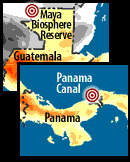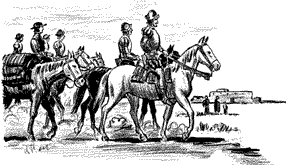|








|
 |
Pick a Region:.
. Central America

Countries
Scholars agree that Central America includes Guatemala, El Salvador, Honduras, Nicaragua,
and Costa Rica. These countries have a long history. In 1821, they declared independence
from Spain, and from 1823 until 1838, they were part of the United Provinces of Central
America (see Politics). Panama was part of Colombia for several
decades but received its independence in 1903. Due to its geographic location, however,
Panama is frequently considered to be part of Central America.

Language
The majority of Central Americans speak Spanish--the language of the
Spanish conquistadors. At the time of
the conquest, many indigenous languages
existed. Some of these still exist today, like in Guatemala, where
23 different Mayan dialects are spoken. In the other Central American
countries, indigenous languages are now less
widespread, but still present.
Image: Rendition of Spanish
conquistadors. Image © 1999 -www.arttoday.com
Race
Most people throughout Central America are mestizo
or ladino. Mestizos are individuals with both indigenous and Spanish
heritage. Dispersed throughout this region are Indian minorities,
ranging from nearly one-half of the population in Guatemala to single
digit percentages in some of the other countries. Small minorities
of European, African, and Asian heritage can also be found in many
of these countries.
Religion
The majority of people in this region are Roman Catholic. In most of these countries, the
Catholic population ranges from 80 to 90 percent. Forcing the indigenous population to
accept Catholicism was not an easy task for the Spaniards. One factor, however, that made
conversion possible was that Catholicism has many saints, and the indigenous religions
have many gods. Hence, for many indigenous peoples, Catholicism has been mixed with
indigenous religions to form a combination of the two religions. In recent years,
evangelical Protestant groups have created challenges to the Catholic Church in Central
America. Protestant groups have aggressively pursued converts in these countries. In some
instances, struggles over converts have resulted in violent conflicts between Catholics
and Protestants. |
 |



    
|

